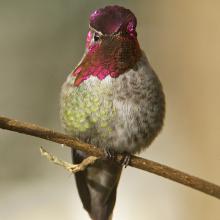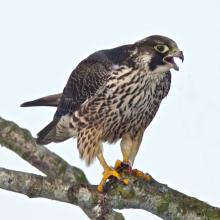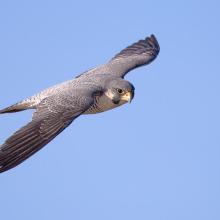

Join BirdNote tomorrow, November 30th!
Illustrator David Sibley and actor H. Jon Benjamin will face off in the bird illustration battle of the century during BirdNote's Year-end Celebration and Auction!
Happy Mother's Day, from the whole BirdNote team!
Avian motherhood is a mixed bag. Peregrine Falcon mothers share duties fairly equally with Peregrine dads. At the other end of the spectrum is the female hummingbird, which usually carries the entire burden of nesting, incubating, and tending the young. And then, there's the female Western Sandpiper: she usually leaves the family just a few days after the eggs have hatched!
Support for BirdNote comes from American Bird Conservancy and Bringing Back the Birds, a photo book by Owen Deutsch on the importance of protecting birdscapes. Available at Amazon.com.
BirdNote®
Mother Birds
Written by Ellen Blackstone
This is BirdNote!
Motherhood. In the avian world, it’s a mixed bag.
Peregrine Falcon mothers share duties fairly equally with Peregrine dads. [Calling of a Peregrine] Both incubate the eggs, although Mom usually spends more time at the task. For the first three weeks after the eggs hatch, she alone broods the young, and the male hunts to feed the entire family. When the young fledge, both parents feed them, and at the same time, teach the young birds to hunt for themselves. [Cakking of a Peregrine]
At the other end of the spectrum is the female hummingbird. [Wing-hum of a Rufous Hummingbird] She usually carries the entire burden of nesting, incubating, and tending the young—a true single mom. The male stays around, but only to protect his territory. He’s mostly a pest! [More wing-hum]
And then, there’s the female Western Sandpiper. [Chattering sound of Western Sandpiper flock] She finishes a nest the male has started. And they share incubation duties. But Mother Sandpiper usually leaves the family just a few days after the eggs have hatched. The male tends the young until they’re able to fly. It makes sense – the female needs to replenish herself. The eggs she laid almost equaled her body weight. [More chattering]
Support for BirdNote comes from American Bird Conservancy and Bringing Back the Birds, a photo book by Owen Deutsch on the importance of protecting birdscapes. Available at Amazon.com.
###
Bird audio provided by The Macaulay Library at the Cornell Lab of Ornithology, Ithaca, New York. Peregrine Falcon recorded by G. Vyn. Hummingbird wing hum recorded by A.A. Allen.
Western Sandpiper calls recorded by Martyn Stewart, naturesound.org
BirdNote's theme music was composed and played by Nancy Rumbel and John Kessler.
Producer: John Kessler
Executive Producer: Chris Peterson
© 2014 Tune In to Nature.org May 2017 / 2020 Narrator: Mary McCann
ID# 051407motherKPLU mother-01b










